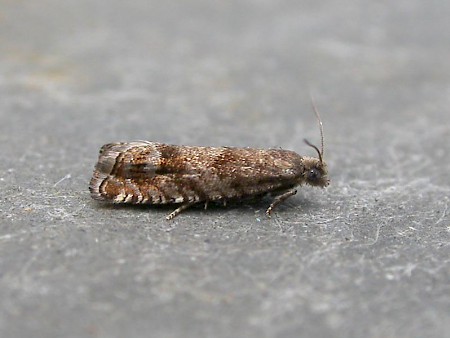49.247 BF1131
Dark Spruce Bell Epinotia subsequana
(Haworth, 1811)
Wingspan 11-13 mm.
This tiny moth is found across the southern regions of England and Ireland, as well as parts of Wales. Its larvae are leafminers that feed on the needles of giant fir, silver-fir and Norway spruce.
On clear, warm days in April and May, adults can be glimpsed flitting high up about their host trees from noon until dusk. The mottled dark browns, whites, and greys of the Dark Spruce Bell’s forewings create the impression of textured tree bark, helping this species to camouflage beneath the foliage during its periods of rest.
While similar in appearance to its close relative, E. pygmaeana, the Dark Spruce Bell has three reliable distinguishing features. The antennae of male Dark Spruce Bells are covered in very short hairs, each less than the width of the antennal shaft. The antennal hairs of E. pygmaeana, in contrast, are much longer. On the forewings of Dark Spruce Bells of both sexes, there is a weak yet discernible black eyespot, which is absent in E. pygmaeana. Finally, the upper surface of the Dark Spruce Bell’s hindwings is a very pale whitish brown, darkening towards the outer margins. E. pygmaeana’s hindwings are a much brighter white with similarly brown outer margins.
Dark Spruce Bell larvae hatch from small clusters of eggs laid along the midrib, or at the base, of young spruce or fir needles. Almost immediately, they begin to bore tunnels from the base to the tip of the needle and back, eventually migrating on to mine older needles as they mature. They overwinter on the ground, under soil or leaf-litter, before emerging from reddish-brown pupae as moths in the spring.
Description: Michela Sisti

 UKMoths
UKMoths 


